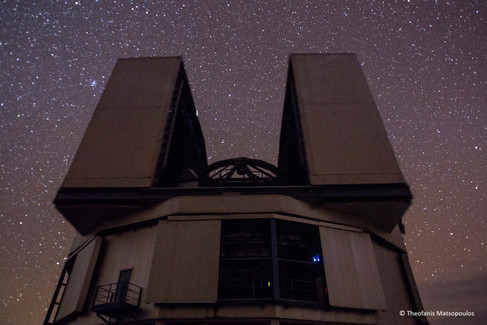A Journey Through the World’s Greatest Observatories
- Theofanis Matsopoulos
- Jul 6
- 2 min read
Updated: Jul 7
There are moments in life when you stand beneath the vastness of the night sky and realize how small yet connected you are to the universe. My journey to some of the world’s largest and most prestigious observatories was one of those moments—an adventure spanning continents, landscapes, and cultures, all in pursuit of capturing the essence of humanity’s quest to understand the cosmos.

Kitt Peak – The Heart of American Astronomy
My first stop was Kitt Peak National Observatory in the Arizona desert. Perched at the top of Quinlan Mountains, this site houses one of the most extensive collections of optical telescopes in the world. The air was dry and crisp, carrying with it the echoes of scientific breakthroughs that had taken place here. The desert silence was occasionally broken by the whir of a telescope, a reminder that, even in the quietest corners of the world, the pursuit of knowledge never stops.
Mauna Kea – Reaching for the Heavens
From Arizona, I traveled across the Pacific Ocean to Mauna Kea, Hawaii, home to some of the most powerful telescopes ever built. At nearly 4,200 meters above sea level, Mauna Kea is a place of extremes. The thin air made each movement slow and deliberate, and the volcanic landscape felt almost otherworldly. As the night descended, the sky exploded into a sea of stars—one of the clearest, darkest skies I had ever witnessed.
Cerro Tololo and Cerro Pachón – The Astronomy Capital of the Southern Hemisphere
The next stop of my journey took me to Chile’s Atacama Desert, a land so dry and high that it offers some of the best conditions on Earth for stargazing. My first destination was Cerro Tololo Inter-American Observatory, where North and South American astronomers have collaborated for decades to explore the depths of space.

Not far away, on Cerro Pachón, the Vera C. Rubin Observatory was underway. This facility, once operational, will map the entire night sky every few nights, capturing transient celestial events like never before. I felt privileged to document this monumental project, knowing that its discoveries could revolutionize our understanding of dark matter, dark energy, and the very fabric of space-time.

ESO’s Very Large Telescope – Pushing the Limits of Discovery
Finally, my journey led me to ESO’s Very Large Telescope (VLT) at Paranal. Located on a remote mountaintop in the Atacama Desert, this observatory is home to four massive 8.2-meter telescopes that can work together as a single, ultra-powerful instrument. As I approached the site, I was struck by the sheer scale of human ingenuity. The VLT’s mirrors are so precise that they can detect exoplanets and distant galaxies in extraordinary detail. Here, in one of the most remote places on Earth, humanity was peering deeper into the universe than ever before.


This expedition was more than just a photographic journey, it was a pilgrimage to the beacons of human curiosity and discovery. Each observatory, with its own unique setting and history, represents a collective effort to answer the most fundamental questions: Where did we come from? What is our place in the cosmos? What mysteries remain beyond our reach?






















































